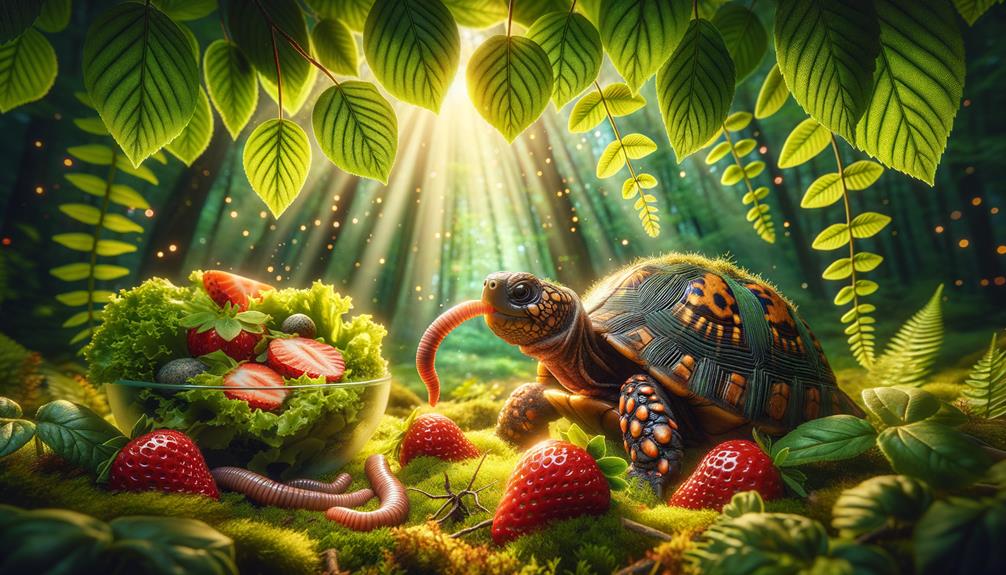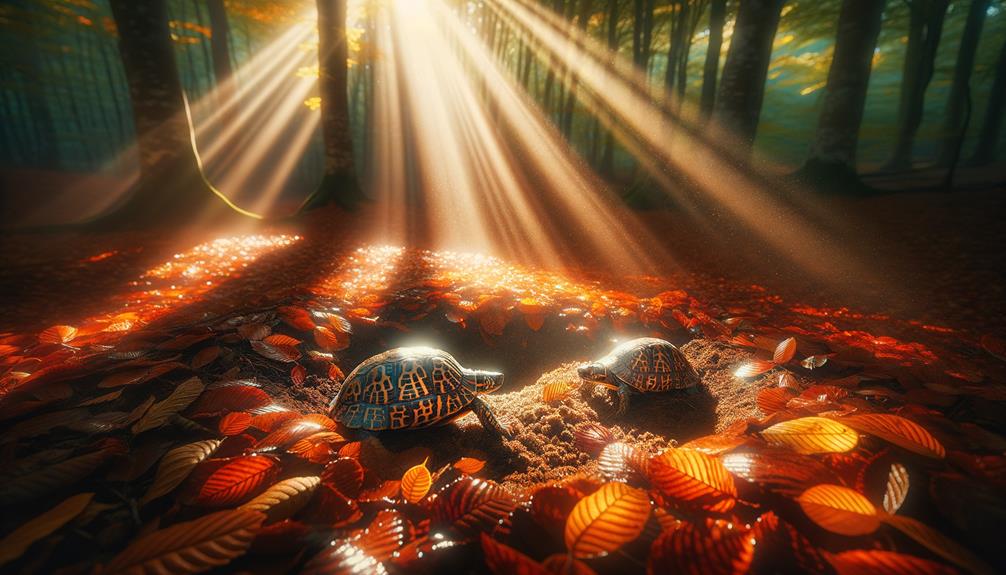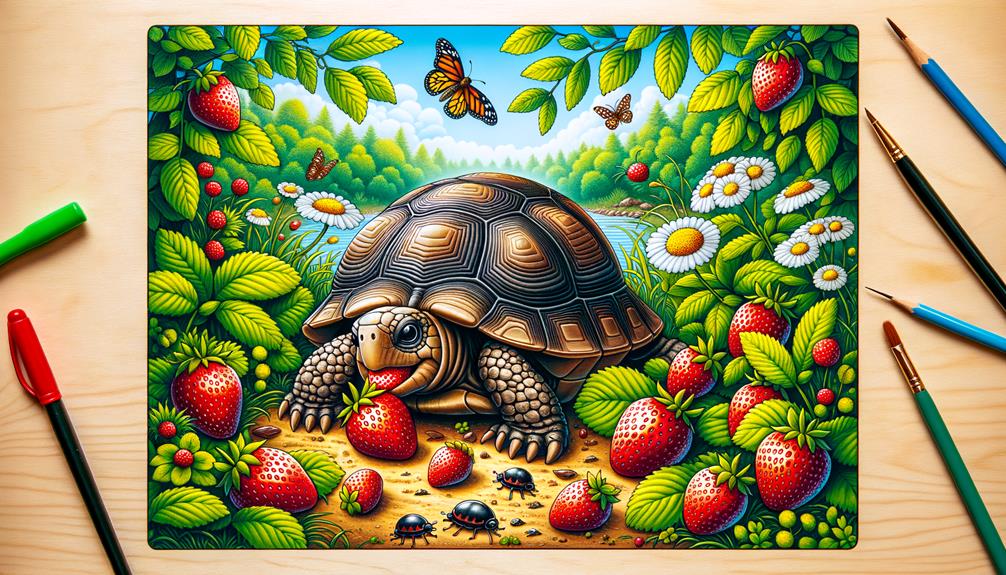I’ve always found box turtles to be absolutely charming with their high-domed shells and striking orange and yellow patterns. These terrestrial reptiles thrive in diverse habitats, from forests to suburban areas. They’re incredibly adaptable, with a varied diet that includes insects, snails, fruits, and even mushrooms. During courtship, they engage in fascinating rituals like head vibration and biting. Box turtles live long lives, sometimes spanning decades, and require healthy habitats for survival. Unfortunately, they face threats from habitat loss and road mortality, making conservation efforts crucial. If you’re as intrigued as I am, there’s much more to learn about these fascinating creatures.
Key Takeaways
Box turtles are charming creatures with a diverse diet that includes insects, snails, fruits, and mushrooms. Their vibrant orange and yellow markings against a dark brown background make them a standout species. The turtles’ high-domed, hinged shell provides robust protection from predators. Additionally, their excellent memory allows them to return to their favorite feeding spots. Unfortunately, habitat loss and road mortality pose significant threats to their survival, highlighting the need for conservation efforts.
Physical Characteristics
Box turtles are truly fascinating creatures, with their distinct high-domed, rounded carapace adorned in vivid orange and yellow markings on a dark brown background. Their shells, or carapaces, not only serve as a protective armor but also as a canvas for nature’s artistry. The plastron, the hinged underside of the shell, is dark brown and equally robust, offering additional protection. I’m always amazed by the combination of durability and beauty in these turtles‘ physical characteristics.
The size of box turtles varies greatly. Typically, they measure around 10 cm by 15 cm (4 in by 6 in), with the Gulf Coast box turtle being the largest subspecies. This size variation is especially pronounced in younger turtles, who exhibit rapid growth rates as they mature. Observing this growth, I appreciate how each turtle’s carapace develops its unique pattern, making every individual distinct.
Furthermore, box turtles possess an incredible ability to regenerate damaged parts of their carapace, a feature that speaks to their resilience. This regenerative capability guarantees that even when faced with injury, these turtles can continue their journey, embodying the spirit of survival and perseverance.
Natural Habitat

Wild box turtles, particularly the Eastern box turtles (Terrapene carolina), are primarily terrestrial and inhabit a wide variety of vegetated areas. They thrive in forests, shrubby grasslands, marshy meadows, and field-forest edges, where they can find ample leaf litter, downed branches, and reliable water sources like streams and ponds.
From Maine to Florida and westward to the Great Lakes and Texas, these turtles adapt well to diverse environments, including suburban areas, as long as they have the necessary habitat requirements for cover, foraging, and breeding. During the mating season, which typically spans from spring to early summer, these environments become crucial for successful reproduction, ensuring that turtles can reach sexual maturity and sustain their populations.
However, wild box turtles face significant threats due to habitat loss and fragmentation. As natural areas shrink, their ability to find suitable habitats and maintain healthy populations becomes increasingly compromised. Turtles often struggle to adapt to these shrinking spaces, highlighting the importance of preserving their natural habitats to support their long-term survival.
Dietary Habits

Feasting on a diverse array of plant and animal matter, these charming omnivores showcase a fascinating dietary versatility that includes everything from insects and snails to seeds and mushrooms. Turtles are omnivores, and this dietary flexibility is especially evident in species like the eastern box turtle and common box turtle, which are found throughout North America.
Their diet can be broken down into several categories:
Insects, snails, and small amphibians make up a significant portion of their diet, particularly for juvenile box turtles.
They consume a variety of seeds, leaves, and fruits. Cantaloupes and tomatoes are among their favorite treats, often raided from gardens.
Mushrooms are a common food source, showcasing their ability to utilize various ecological niches.
Box turtles have excellent memories, often returning to favored feeding spots.
Female box turtles and males alike benefit from this diverse diet, which is vital for their health and well-being. In captivity, it’s essential to replicate their natural diet to ensure they receive all necessary nutrients. Observing these turtles’ feeding habits provides a glimpse into their complex and adaptable lives.
Reproductive Behavior

During the breeding season, which spans from April to October, these fascinating creatures engage in elaborate courtship rituals that highlight their unique reproductive strategies. Males attempt to win over females by performing a series of behaviors, including walking around them, vibrating their heads, and occasionally biting the female’s legs. This essential display is crucial for species like the Gulf Coast box turtle, the three-toed box turtle, and the Coahuilan box turtle.
What’s truly remarkable is that females have the ability to store sperm for up to four years, allowing them to lay fertile eggs every year without needing to mate annually. This adaptation guarantees the survival of their species even in years when mating might not occur. Typically, females lay 4-6 leathery eggs per nest in late spring. They carefully dig shallow depressions in soil or leaf litter to place their eggs, which incubate for approximately 60-80 days.
The temperature of the nest determines the sex of the hatchlings, an amazing natural mechanism ensuring gender balance. Hatchlings take 5-10 years to reach sexual maturity, continuing the cycle of life. Box turtles’ unique reproductive behaviors demonstrate their incredible adaptability and resilience in diverse environments.
Conservation Status

Box turtles face significant threats, including habitat loss and road mortality, which jeopardize their stable population numbers and ecological roles in eastern North America. Despite being classified as a species of least concern, their survival is far from guaranteed. I’ve witnessed how habitat fragmentation in states like North Carolina, Tennessee, and Florida impacts these charming omnivores, making conservation efforts more crucial than ever.
To ensure their survival, we need to focus on:
- Preserving Natural Habitats: Maintaining and restoring connected, healthy habitats is vital for their survival.
- Reducing Road Mortality: Implementing measures like wildlife corridors and road crossings can significantly reduce road mortality.
- Raising Awareness: Educational programs and initiatives help raise public awareness, garnering support for conservation efforts.
- Community Engagement: Engaging local communities in monitoring and research efforts provides valuable data and fosters a sense of responsibility.
Box turtles serve as indicators of the health of their forest and wetland habitats. By prioritizing their conservation, we’re not just protecting these reptiles but also safeguarding broader ecological systems. In states across the North, from North Carolina to Tennessee to Florida, dedicated efforts are necessary to ensure box turtles continue to thrive in their natural habitats.
Interesting Facts

Delving into the fascinating world of box turtles reveals their remarkable longevity, with some individuals living over a century. This incredible lifespan places them among North America’s longest-lived reptiles. Box turtles, particularly the eastern variety, have a unique adaptation that contributes to their survival – their domed, hinged shell. This shell allows them to retract completely inside, offering a formidable defense against predators.
Their habitat is equally intriguing. Native to eastern North America, box turtles favor moist, wooded areas with ample access to water. These environments provide the perfect conditions for their varied omnivorous diet, which includes insects, small vertebrates, fruits, and vegetation. This diverse diet not only sustains them but also plays a role in their impressive longevity.
Despite being classified as a species of least concern, box turtles face significant threats from habitat loss and road mortality. Conservation efforts are vital to ensure these charming omnivores continue to thrive. Understanding their needs and challenges is crucial for their protection. By preserving their natural habitats and mitigating human-induced threats, we can help safeguard the future of these remarkable creatures for generations to come.
Frequently Asked Questions
What Are 5 Interesting Facts About Box Turtles?
they can live over a century, sport vibrant shells, eat both plants and animals, thrive in moist wooded areas, and face threats like habitat destruction and road accidents.
Can I Keep a Box Turtle I Found in My Yard?
You’re considering keeping a box turtle you found in your yard, but it’s not a good idea. Removing them from the wild is illegal, and their specific habitat needs and long lifespans make them challenging to care for properly. It’s vital to prioritize conservation.
What Are Box Turtles Attracted To?
Box turtles are drawn to areas with high humidity, abundant leaf litter, and a diverse range of food sources, including wild berries, insects, and small vertebrates. They thrive in environments that offer shelter, foraging spots, and preferred feeding and resting locations.
Can Ornate Box Turtles Eat Strawberries?
Ornate box turtles can safely eat strawberries as an occasional treat. Strawberries are a good source of vitamin C, providing 149% of the daily requirement per 100g. To prevent digestive issues, I cut them into bite-sized pieces before offering them to my turtles.



